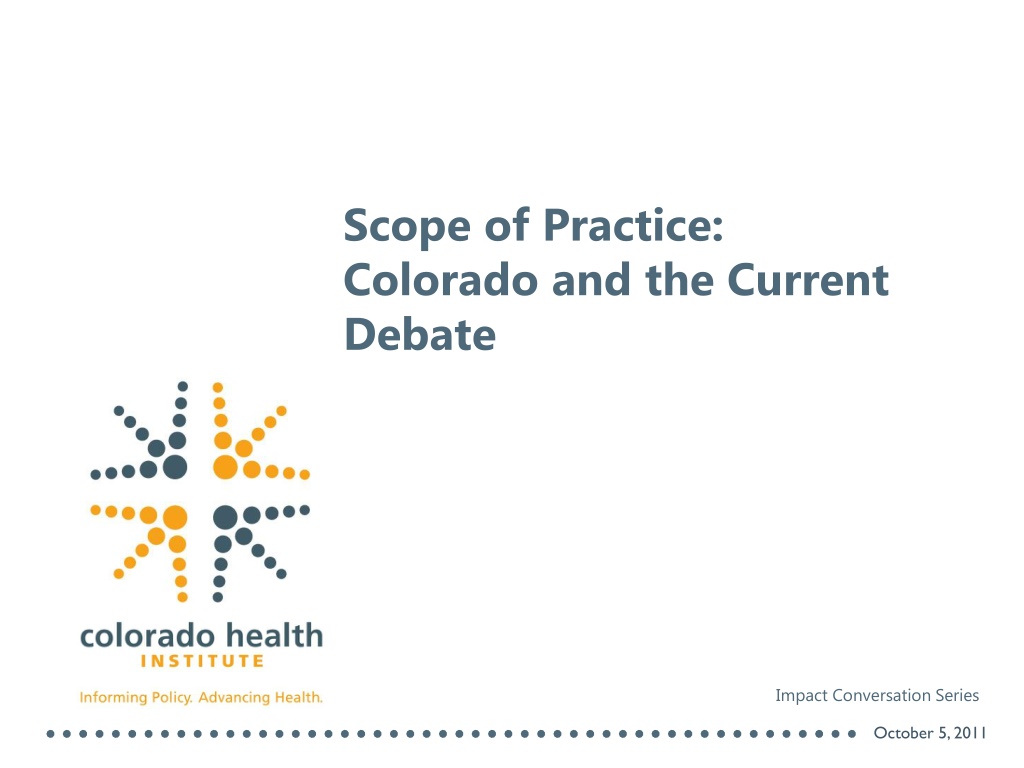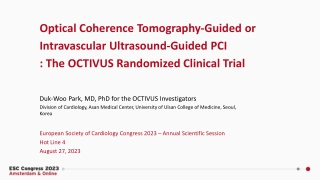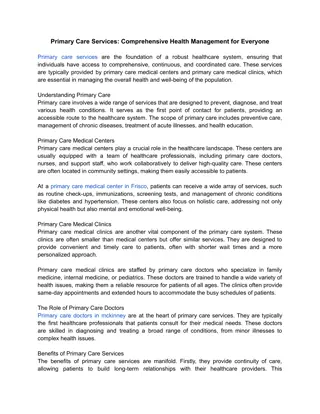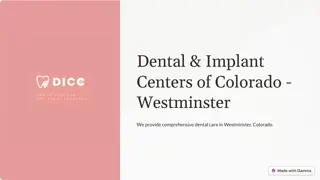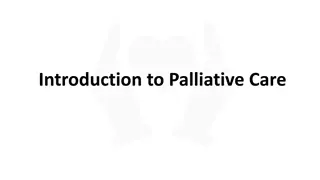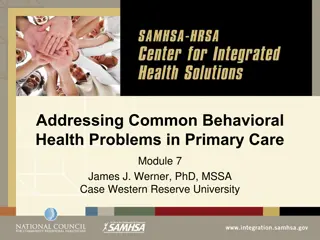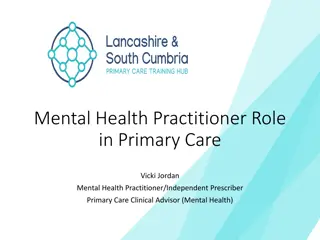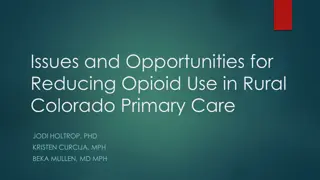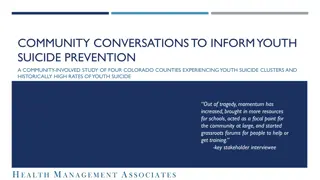Primary Care Scope of Practice Debate in Colorado (Oct 2011)
Discussion on the current debate surrounding primary care scope of practice in Colorado, focusing on the increasing demand for care, gaps in services, and the different healthcare professionals involved. The conversation addresses the training, regulatory, financial, and cultural aspects impacting primary care providers.
Download Presentation

Please find below an Image/Link to download the presentation.
The content on the website is provided AS IS for your information and personal use only. It may not be sold, licensed, or shared on other websites without obtaining consent from the author. Download presentation by click this link. If you encounter any issues during the download, it is possible that the publisher has removed the file from their server.
E N D
Presentation Transcript
Scope of Practice: Colorado and the Current Debate Impact Conversation Series October 5, 2011
Todays Discussion Primary Care: A booming market The National Conversation State of the Debate in Colorado APN & PA Survey Findings Planning now for new solutions Training Regulatory Financial Cultural 2
On the Horizon: Primary Care Need In Colorado 500k more newly insured How much care will they seek? Where will they seek care? 214,000 153,000 175,000 4
Who Can Practice Primary Care? Medicine Nursing Physicians Nurse Practitioners (NPs) Clinical Nurse Midwives (CNMs) Physician assistants (PAs) 6
Scope of Practice Training & complexity of care Sub- specialist MDs MAs CNAs LPNs RNs PAs APNs Generalist MDs Specialist MDs Cost-effective care & providers, access 7
Progression of the Debate Training Curriculum Certification Regulatory Licensing Statutes Financial Insurance empanelment Reimbursement Billing Cultural 8
The Importance of Frame of Reference Nursing Perspective Physician Perspective IOM Perspective Graham Center Growing literature: plenty for everyone 10
National-level reform Mid-to-long range change Federal role Immediate term change State role 11
The Promise of Medical Homes Reduced costs Improved care quality Reduced medical errors Higher patient satisfaction Fewer health disparities 12
The Promise Deferred Not today or tomorrow Require transformation Workforce as members of care teams Technology is not plug and play Health care neighborhoods Payment reform 13
Accountable Care Organizations A model for reforming health care delivery and payment Integrated care delivery Payments linked to cost-reducing quality benchmarks Performance measurement 14
Scope of Practice: Market Dynamics Cost/Value Efficiency Access & Choice Mal-distribution Educational capacity Reimbursement Payment reform Medical homes Delivery models 15
Our Primary Care Workforce Primary Care Providers per 100,000 population US Colorado* 90 65 30 28 15 8 Physicians NPs PAs NOTES: Estimates do not include non-primary care practitioners. *Colorado providers include practicing/working providers only. SOURCES: GAO, Peregrine, DORA, Colorado Office of Demography, CHI) 17
State Role: Leverage Points Practice Acts (legislative decisions) Medicaid payment structure Insurance regulation 18
Scope of Practice: APNs Pre-2008 2008 2009 2010 2011 Graduate degree required National certification required Education program OR certification APN physician collaborative agreement dropped Prescriptive authority for APNs Medicaid reimbursement for all APNs APN insurance empanelment? 20
Colorado NPs No primary care specialty 32% Primary care specialty 68% NOTE: The total of all specialties sums to more than 100% because each respondent could select more than one specialty. SOURCE: 2010 Colorado Advanced Practice Nurse Workforce Survey, Colorado Health Institute, Q14, Q15, Q24
NPs: Many recent graduates Year of graduation 46% 31% 14% 9% 1980 or before 1981-1990 1991-2000 2001 or after 23
NPs: A homogenous profession Gender Race-ethnicity Hispanic /Latino 2% Male 9% White, not Hispanic 94% Female 91% NOTE: The total of all specialties sums to more than 100% because each respondent could select more than one specialty. SOURCE: 2010 Colorado Advanced Practice Nurse Workforce Survey, Colorado Health Institute, Q14, Q15, Q24 24
NPs: Age and career cycle 36% 21% 19% 18% 5% 34 years or younger 35 - 44 years 45 - 54 years 55 - 64 years 65 years or older 25
NPs: Policy opinions Enforceable policies establishing reimbursement commensurate with clinical services provided 95% Institutional policies that reflect APN scope of practice under law 95% Physician-APN convenings on issues of scope of practice and collaborative models of care 92% 26
Colorado PAs Specialty & gender 1200 1000 Number of PAs 800 Male Male 600 400 Female (60%) Female (75%) 200 0 Primary Care 43% of PAs Specialty Care 57% of PAs *PAs were classified as primary care if they practiced family/general medicine, general internal medicine, general pediatrics or prevention/wellness at least 50% of their practice time during a typical work week. SOURCE: CHI: 2011 Physician Assistant Workforce Survey, Q24, Q17, Q1. 27
PAs: Increasingly educated <29 30-39 40-49 50+ Education and age 60% 58% 43% 36% 33% 31% 31% 29% 27% 16% 13% 13% 9% 1% 0% 0% Associate's Degree Bachelor's Degree Certificate Master's Degree SOURCE: CHI: 2011 Physician Assistant Workforce Survey, Q24, Q2, Q13 28
PAs: Policy opinions State/federal loan forgiveness for those PAs practicing in underserved areas of Colorado 98% Private reimbursement that reflects equal pay for equal work 90% Allow home health, SNF and hospice care ordering to be delegated to PAs under Medicare 85% SOURCE: CHI: 2011 Physician Assistant Workforce Survey, Q8 29
What the surveys tell us: Important primary care providers Meeting higher education standards Some of the same issues as physicians NP issues: Reimbursement, institutional policies, physician convenings PA issues: Reimbursement and Medicare scope 30
The late stages of the debate Interdisciplinary education Training Monitor mentor/preceptor availability Insurance empanelment DORA Data Bill Regulatory Reimbursement, billing Payment reform/health exchange policy Nurse-led health centers Financial 32
Are the Changes Enough? Calls for Disruptive Innovation Clinician-led teams, practices Telehealth Leveraging new practitioners: Community health workers/patient navigators/care managers? Training Regulatory Financial Innovation 33
Options Moving Forward Aligning financial structures & institutional policies Paying for value Building consensus: NPATCH Support for loan forgiveness Evaluate Community health worker models 34
